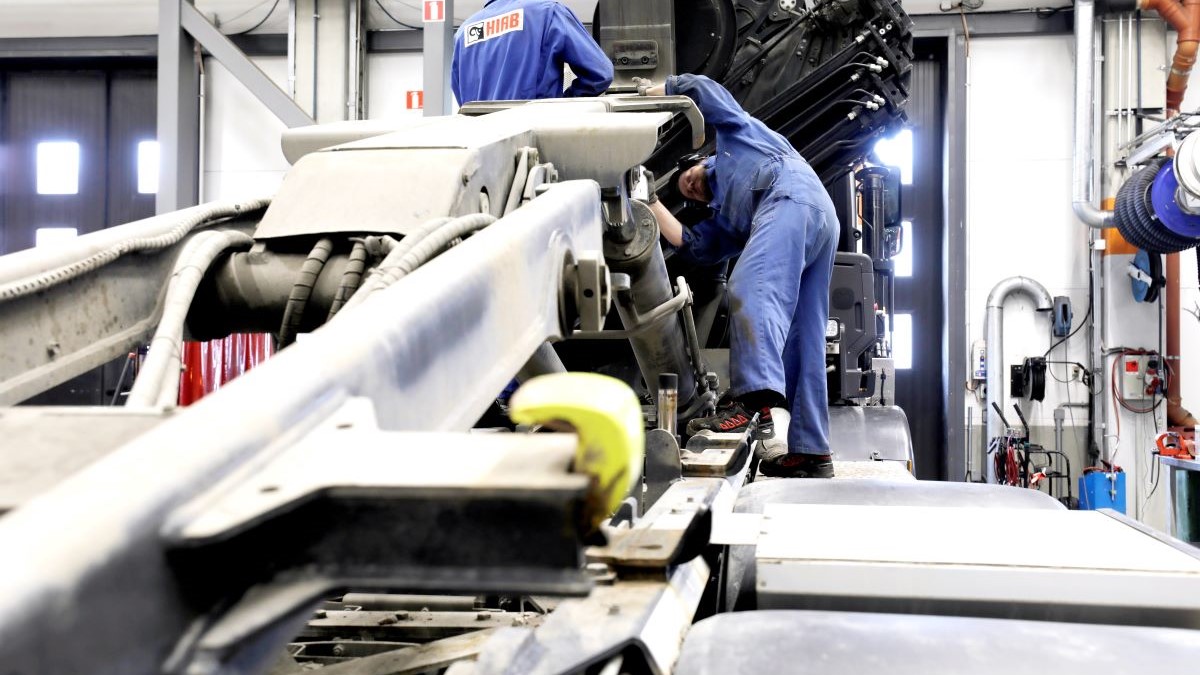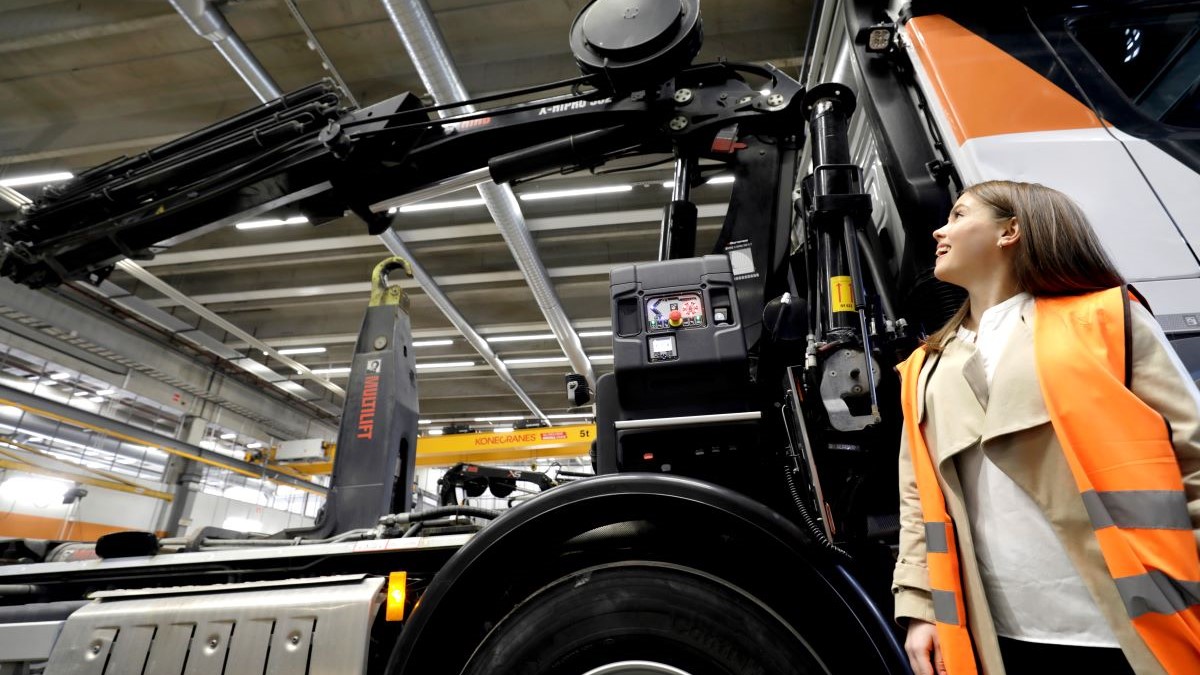Dr Hanna Grönqvist, who holds a PhD in theoretical physics, develops solutions enhanced by artificial intelligence (AI) to the Hiab portfolio of load handling equipment and intelligent solutions. In one such solution, namely predictive maintenance, data is used to get insight about machine breakdown prior to it even occurring. Hanna was drawn to this field of work by the potential of science to solve some of the major problems in the world.

Hanna Grönqvist develops solutions enhanced by artificial intelligence (AI)
The start to a career in AI came when I fell in love with the magical world of particle physics and science already in high school when visiting CERN, the European Organization for Nuclear Research. After high school, I began my studies in theoretical physics and got an internship at the CERN particle accelerator complex. From there, my path took me to Erasmus studies in France, where I also did my doctoral thesis and spent the first years of my career.. After seven years abroad, I noticed that Cargotec was looking for data scientists. The values at Cargotec – sustainability, ethics and inclusiveness – appealed to me. I applied and got the job. After a few years, I transferred to the Services division of Hiab, one of the business areas of Cargotec, where my responsibilities include developing solutions using artificial intelligence for the predictive maintenance of load handling equipment.
To me, artificial intelligence is a tool kit to solve problems and improve the status quo. Artificial intelligence per se is not interesting but what it can be used to achieve is. When it comes to the future of the planet, we are already running out of time, but I believe that through science we have the keys to finding solutions to big issues such as the environmental and climate problems.
"The specific shape and form of the benefits of artificial intelligence can be surprising. For a company to have its data and relevant processes in place already brings significant added value.”
Artificial intelligence is useful in many respects, but often it is actually the steps leading up to a solution powered by it that provide the most significant benefits. For a corporation to have its data and relevant processes in order already brings significant added value. Artificial intelligence as such really is not very smart - it is merely a tool for solving large problems.
I have achieved various things using AI, but one of the most interesting ones was conceived last spring when the COVID-19 pandemic hit. Me and a colleague developed a tool using AI to follow developments in the economy. This index, which follows the activity of the markets, uses telemetry data collected from our load handling equipment globally. Real-time data is useful for managers whenever there is a need to react fast.
In this field of work it is necessary to have some mathematical background and to know programming, but it is also important to have communication skills and know how to use storytelling to convey the data-driven insights. At the end of the day, scientific results and innovation only have the value that their users allocate to them. If I were to invent a revolutionary solution but did not manage to convince others of its importance, it would effectively be worthless. Coding machine learning algorithms is actually surprisingly easy, the hard part, requiring a scientific mindset and rigour, is the ability to question your own problem setting as well as the vigilance to spot the bias you might have inserted into any solution.
"The best aspect of my daily work is my colleagues. This kind of work really is not about going it alone, but about collaboration and finding the right approach to solving a problem together."
One of the most common misconceptions about AI that I encounter is thinking that it is such new technology and even a form of black magic. It really is not - we apply precisely the same scientific methods and reasoning that Galileo and Copernicus did in their day. They would observe celestial bodies and keep track of their coordinates for long stretches of time. This logic of observing phenomena, book-keeping of data and then modeling is precisely the same today! The relatively novel aspect is that computers are used and therefore it’s possible to crunch many more numbers than was possible before. And let’s not forget that AI has been around since the 60s. Many fears are related to it, but those fears make me think about how people during the second industrial revolution were afraid of going onboard a train, which was the latest technology of the time.

The pictures are taken from Hiab's service and installation centre in Helsinki, Finland
Using AI, I would like to participate in creating a future, where “sustainable material flow” is no longer perceived as a contradiction. Aligned with our values at Hiab, we are developing sustainable solutions for load handling worldwide. Being involved in this development is a huge motivation in my daily life. I have learned that new developments typically happen incrementally and that by taking one small step after the other it’s possible to go far.
One of the solutions in which we use artificial intelligence at Hiab is predictive maintenance, where we catch machine failures before they even happen. Our goal is to have the equipment repaired before it causes any headache to our customers. The fact that Hiab’s equipment is used in such a variety of operating conditions around the world makes predictive modeling particularly challenging. Our thousands of units connected globally continuously send data to the cloud - different equipment measures are collected using telemetry and when combining this data with our service records, artificial intelligence is used. This combination of real-time equipment data with the historical service operations helps us evaluate how equipment operating in a specific environment needs to be maintained.
A problem with such different equipment operating conditions is that practically infinite data collection would be required for all operative factors to be accounted for. However, in businesses you always need to find a balance between data collection and the value it brings. To put this concretely: what are the problems it is worth trying to tackle using AI? Which are the spare parts that are worth the data collection needed for predicting their failure?
Artificial intelligence has proved to be valuable at Hiab for making models to anticipate upcoming service needs. Simply replacing unexpected downtime by expected stops is valuable. We are only starting this journey but we have all the prerequisites for success: a global connected fleet, IoT (internet of things) cloud infrastructure with its computational power and all the relevant experts. It is such a booster for motivation to know that there is still a lot to develop!

We have learned that building the foundations for AI solutions requires care and that it can take years to see the fruit of that labour. However, sometimes you start reaping the benefits already while setting up these foundations and the precise shape and form of those benefits might come as a surprise. One of the side products we have had is a deepened understanding of our equipment’s service needs in different conditions. Another important lesson learned is that building AI-driven solutions is first and foremost teamwork and change management, not only technology.
My message to companies interested in AI is an invitation to ask yourself whether you or any other company really can afford not to be data and AI-driven anymore.
Text: Sini Kaukonen
Photographs: Liisa Takala
The interview was originally published in Finnish by Technology Finland who has kindly given us permission to share it.
